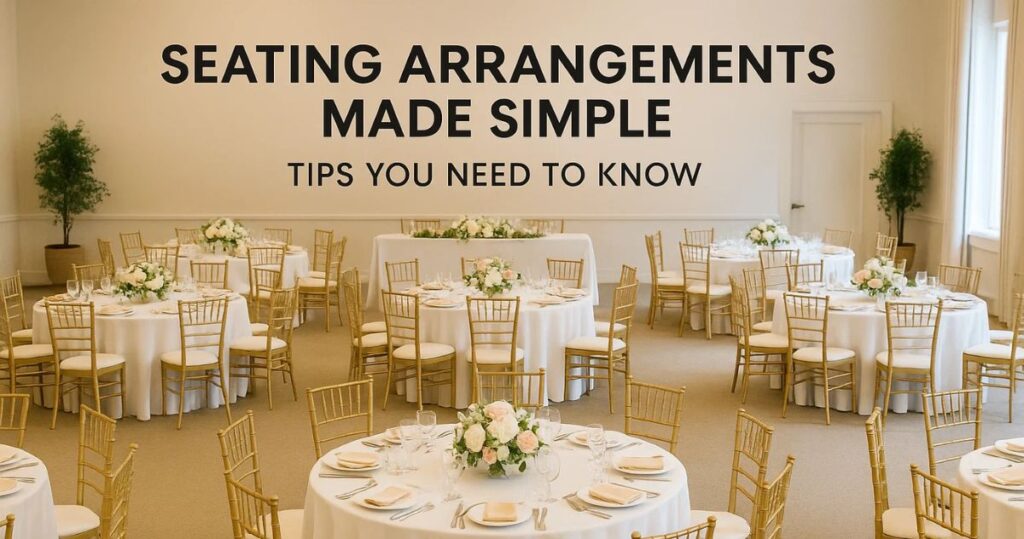When planning a wedding or any large-scale celebration, few elements influence the guest experience as much as the seating arrangement. It’s more than just placing chairs and tables; it’s about creating a harmonious setting where guests feel comfortable, engaged, and connected. A well-planned seating layout can elevate the ambiance, spark conversations, and ensure the event flows effortlessly.
Whether your celebration is happening at outdoor party halls in Chennai or any other beautiful venue, understanding the art of seating arrangements is essential. Let’s dive into practical tips and insights to make this process simple and stress-free.
Why Seating Arrangements Matter
Seating arrangements do more than dictate where guests sit. They influence the overall event experience by:
- Promoting Social Interaction: Grouping people who know each other, or share similar interests, helps conversations flow.
- Creating a Comfortable Environment: Guests should feel included and have an unobstructed view of key moments.
- Avoiding Awkwardness: Proper planning prevents uncomfortable pairings and ensures that everyone feels valued.
A thoughtful seating plan reflects your attention to detail and hospitality—key ingredients for a successful wedding.
Step 1: Understand Your Venue Layout
Before you start planning, review the venue’s floor plan. Outdoor Party Halls often provide flexibility, with open spaces that allow for creative layouts like circular seating or lounge-style setups. On the other hand, reception Halls usually have a more structured layout, which is ideal for formal seating plans.
Key considerations:
- Check the shape of the space—square, rectangular, or irregular.
- Identify key areas: stage, buffet stations, dance floor, and entrances.
- Ensure there’s enough room for free movement between tables.
Step 2: Choose a Seating Style
The right seating style depends on your event’s theme, guest count, and venue type. Here are popular options:
1. Banquet Style
- Best For: Traditional receptions in indoor settings.
- Features: Round tables seating 6–10 guests.
- Benefits: Promotes interaction among guests.
2. Family-Style Long Tables
- Best For: Outdoor venues with a rustic or casual theme.
- Benefits: Creates an intimate dining experience and looks stunning in open spaces.
3. Lounge Seating
- Best For: Informal gatherings or cocktail-style receptions.
- Benefits: Perfect for outdoor party halls, adding a relaxed vibe with sofas, chairs, and coffee tables.
Step 3: Organize Your Guest List
A well-organized guest list is the backbone of a successful seating arrangement. Here’s how to streamline the process:
- Divide Guests by Groups: Family, close friends, colleagues, acquaintances.
- Identify Special Needs: Elderly guests, children, or anyone requiring easy access to exits.
- Balance Relationships: Avoid seating people with strained relationships at the same table.
Step 4: Create a Seating Chart
Once you know your groups, create a seating chart that aligns with your layout. Digital tools like AllSeated, WeddingWire, or even simple spreadsheet templates can make this task easier.
Tips for an effective chart:
- Place close family and VIP guests near the stage or couple’s table.
- Keep kids together at designated tables with fun activities.
- Position elderly guests away from loudspeakers or high-traffic areas.
Step 5: Plan for Outdoor Challenges
If your event is in one of the beautiful Outdoor Party Halls, weather can influence your seating plan. Consider these tips:
- Have a Backup Tent or Canopy: Protects against unexpected rain or harsh sunlight.
- Secure the Seating: Use weighted chairs or anchor décor to withstand wind.
- Provide Comfort: Add cushions or fans for warm weather and heaters for cooler evenings.
Step 6: Optimize Flow and Accessibility
A good seating plan allows guests to move around comfortably. Here’s what to keep in mind:
- Leave Aisles: Ensure enough space for servers and guests to walk without congestion.
- Place Key Tables Strategically: Buffet or dessert tables should be accessible to all.
- Dance Floor Proximity: Guests who enjoy dancing will appreciate being near the action.
Step 7: Use Escort Cards or Digital Displays
Clear communication prevents chaos. Escort cards or digital screens at the entrance help guests find their seats quickly. If your reception is in a grand indoor space like reception Halls, digital displays add a modern touch, while for outdoor venues, rustic signboards can complement the setting.
Step 8: Be Flexible
Even with perfect planning, last-minute changes happen—unexpected guests, cancellations, or reshuffled tables. Keep a few extra seats handy and maintain flexibility to adjust without stress.
Pro Tips for Stress-Free Seating Arrangements
- Start Early: Begin planning as soon as RSVPs start coming in.
- Ask for Input: Get insights from close family or friends for better pairings.
- Focus on Comfort Over Perfection: A relaxed, happy atmosphere matters more than rigid rules.
- Hire an Expert: If managing seating feels overwhelming, consider a wedding planner to handle logistics.
Final Thoughts
Seating arrangements might seem like a small detail, but they play a big role in ensuring guest comfort and smooth event flow. Whether you opt for an elegant indoor setup at one of the top reception halls in Chennai or choose a beautiful outdoor venue, a well-planned seating layout guarantees that your guests feel welcomed and enjoy every moment of your celebration.
Plan thoughtfully, use the right tools, and focus on guest comfort—because when your guests are happy, your big day becomes truly unforgettable.

